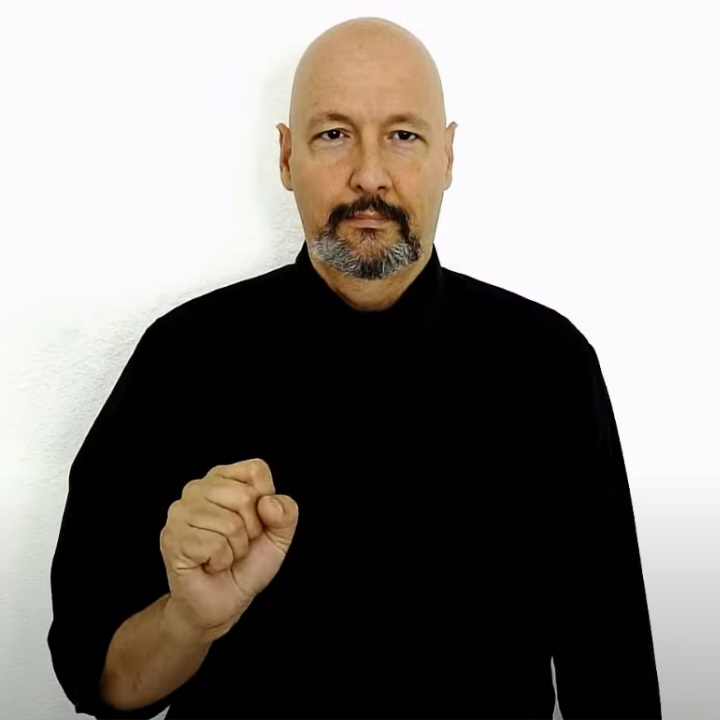Down Syndrome: The
American Sign Language (ASL) sign for "Down Syndrome"
Down Syndrome (Version 1)
There is an ASL sign that has been used for many years to mean "Down
Syndrome."
is typically quite straightforward and descriptive.
Begin with your dominant hand in a "D" handshape, palm forward at about the
level of your forehead or (if done more casually) near the upper cheek.
Move your hand downward a couple of inches along the side of your face,
ending in an "S" hand near your chin.
The downward movement can be though of as representing the concept of "down"
in "Down Syndrome." The nearness to the face is likely associated in most
people's minds with the tendency for people with down syndrome to share a
particular set of facial features.
As of this writing, (in 2023) a significant number of skilled signers
recognize and do the above described sign as their sign for Down Syndrome.
However, as with many signs that describe populations of people there are
subsets of the population that are not satisfied with the existing sign and
feel it is negative. There are others however who feel like the sign
is fine and that respect or disrespect lies not with the sign but rather
with the attitude shown in the facial expression or mannerisms of the person
doing the sign.
In any case all skilled ASL / English Interpreters should recognize the
face-based sign for Down Syndrome in case a client chooses to use or prefers
that version of the sign.
Down Syndrome (Version 2)
A less controversial approach to the sign for Down Syndrome is to spell "DS" in
the neutral fingerspelling space with a very small downward movement as you
change the D into an S.
DOWN-SYNDROME (Version 2, neutral fingerspelling space)


Down Syndrome:
Notes:
In an online discussion group a mother wrote:
[Paraphrased and some details changed for flow and to protect privacy.]
Question:
"I am learning ASL in order to teach my daughter so she can communicate more
affectively. She is not Deaf (just some mild hearing loss) but she has
developmental delays and significant speech difficulties. She also has trouble
processing verbal input without some visual information to go along with it. She
seems to be very receptive to learning and using ASL. Many kids with Down
Syndrome (which is what she has) also have auditory processing disorder. Which
is kind of like dyslexia but for hearing. I have been having trouble explaining
to the people in the Deaf meet-up groups I participate in why I am teaching her
ASL. They just want to know if she is Deaf or Hearing. Part of my challenge is
because my own ASL vocabulary is limited and Iím not able to explain complex
situations. But I also think maybe there is a cultural barrier? How common is it
for nonverbal people who are not deaf to use ASL to communicate? Are they
accepted into Deaf culture / Deaf community? And I was told that there is a more
politically correct way of signing autism now (the within self version) but not
Down Syndrome and that the sign for Down Syndrome is not very nice. Is there
maybe another sign for Down Syndrome (besides DS on the side of the face) that
maybe this person didnít know about?
Response:
It is fairly common for non-voicing or intermittent non-voicing individuals to
learn sign language as a way of increasing their communication options.
The acceptance (or not) of any individual into the Deaf Community has a lot to
do with the individual's attitude - a willingness to put in the effort to learn
ASL (and then doing it!), a humble approach, patience, exhibition of respect for
Deaf norms, and an investment of time.
My recommendation as far as sharing of information as to why you are learning
would be to simply sign: MY DAUGHTER HH.
If you feel like sharing more you could sign:
MY DAUGHTER HH PLUS AUTISM AND DS (done in the neutral fingerspelling space with
perhaps a very small downward movement from the D to the S).
I'll also suggest that when people claim that any particular sign is offensive
it might be good to think of it as them stating that the particular sign is
offensive to "them" -- but keep in mind that any one individual (guru or
otherwise) doesn't speak for the whole Deaf community and that there will always
be a subset of any community that pushes for their opinion of political
correctness.
For example I recall back in 1985 a fellow Deaf person "corrected me" in regard
to the term Deaf -- stating that I should use the term Hearing Impaired. This
was not a Hearing person criticizing me but rather it was a DEAF(!) person
telling me (in 1985) that the correct term (to not be offensive) was HEARING
IMPAIRED (using the point at ear and the INTERRUPT sign).
Political correctness is a moving target that changes form from critic to critic
and day to day.
I just do what I reasonably can to be decent and kind and realize that I will
never satisfy everyone because everyone can't agree on much of anything -- and
as soon as they do -- someone will move the goalpost.
- William G. Vicars, EdD (Bill)
Also see: AUTISM
The sign for Autism:
https://youtu.be/W-hU2HfZSq8
The sign for Usher's Syndrome:
https://youtu.be/NTAMaNkXp4U
*
Want to help support ASL University? It's easy:
DONATE (Thanks!)
* Another way to help is to buy something from Dr. Bill's "Bookstore."
* Want even more ASL resources? Visit the "ASL Training Center!" (Subscription
Extension of ASLU)
* Also check out Dr. Bill's channel:
www.youtube.com/billvicars
You can learn American Sign Language (ASL) online at American Sign Language University ô
ASL resources by Lifeprint.com © Dr. William Vicars